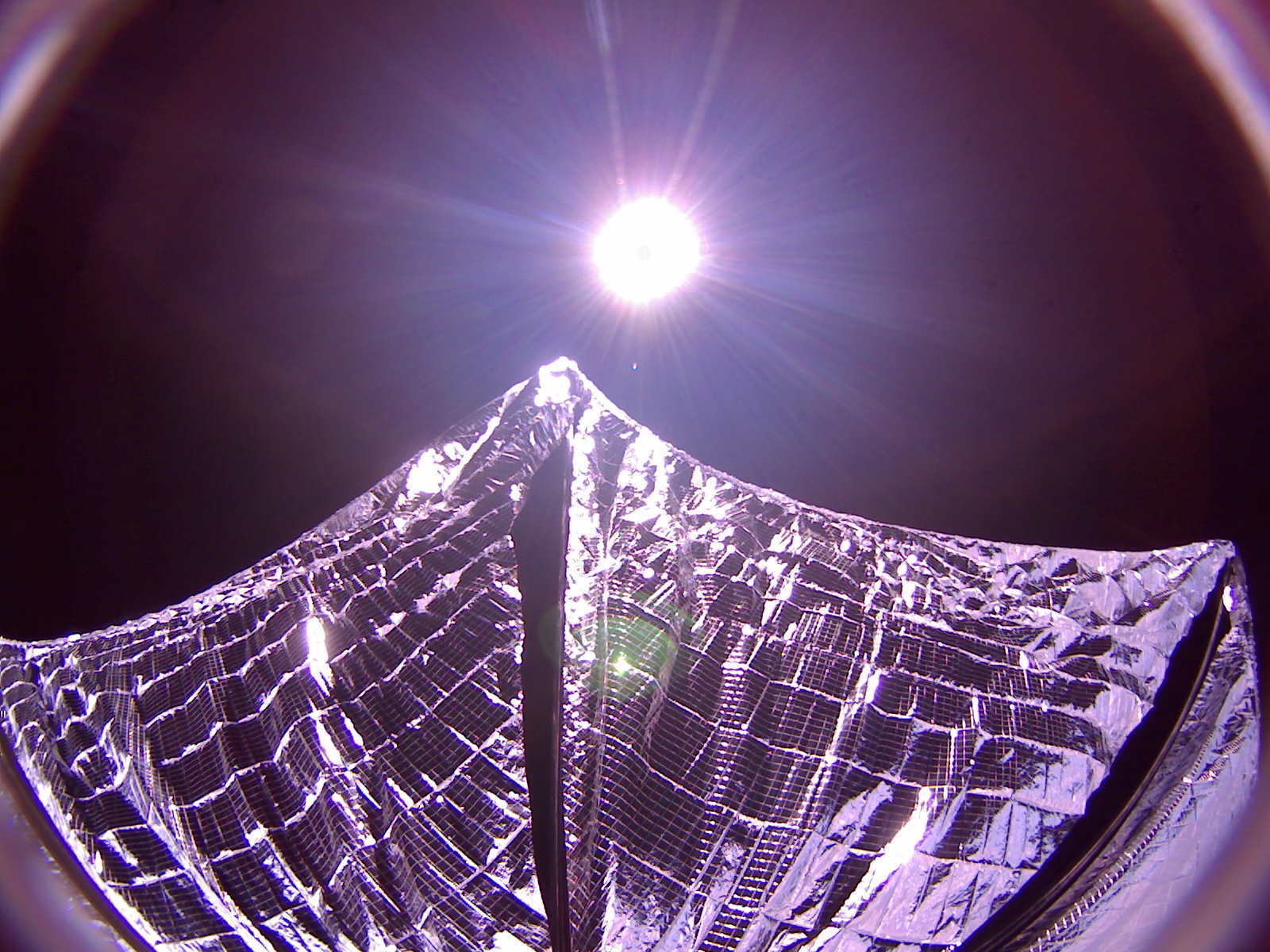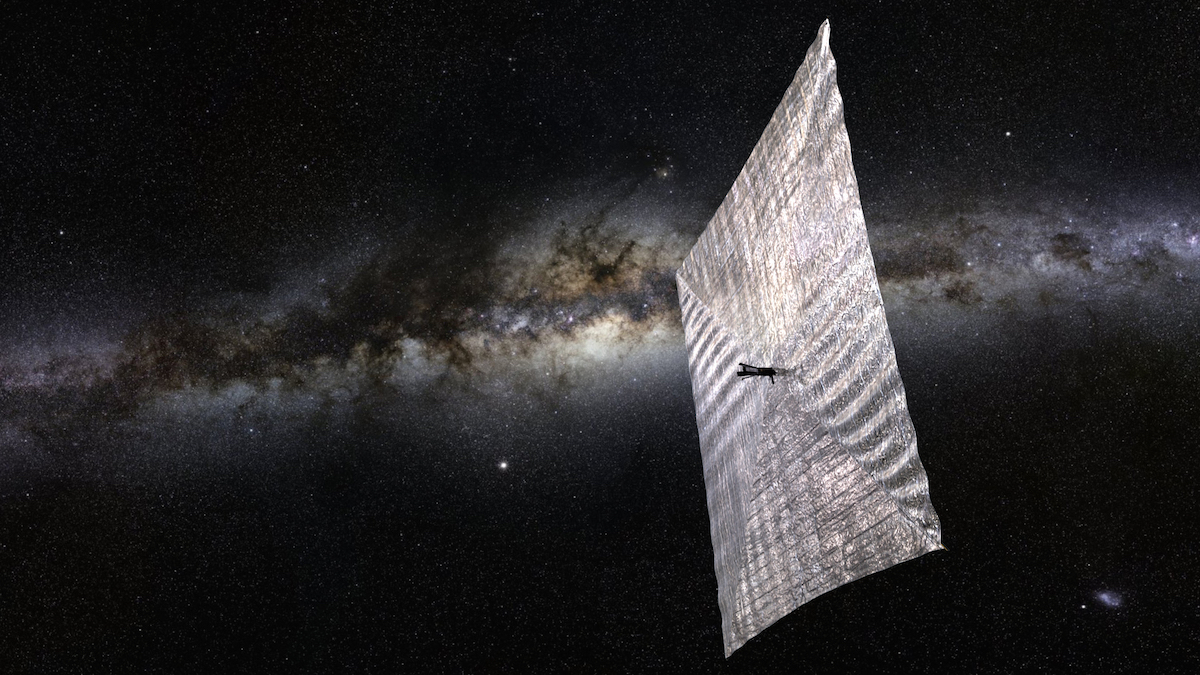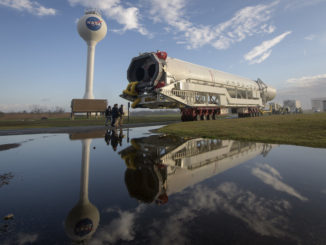
Managers in charge of the privately-funded LightSail solar sail in Earth orbit said Wednesday the success of the experiment is a step toward opening up the solar system to scores of modest science probes that could explore space at a fraction of the cost of traditional government-backed missions.
The LightSail spacecraft opened up a 344-square-foot sail Sunday from a container smaller than a shoebox. It was the third time a solar sail successfully deployed in space, but it is the largest such device to ever unfurl from a CubeSat.
LightSail later downlinked an image of one segment of the deployed solar sail.
The popular CubeSat platform is a relatively inexpensive satellite design commonly used by research institutions, universities, government agencies and start-ups to conduct experiments in orbit.
“Ours is a three-unit, or 3U, CubeSat, so it’s 10 x 10 x 30 centimeters (4 x 4 x 12 inches), and that sail deployed bigger than most living rooms,” said Bill Nye, chief executive of the Planetary Society, an advocacy organization which manages the LightSail project. “So we’re very pleased because the sail really did deploy, and we got some very nice images, and one so far that really has my heart. It’s beautiful.”
Scientists want to send CubeSats beyond Earth orbit in the future to allow researchers to access the moon, asteroids and other planets at more affordable costs.
Nye said solar sails are a good substitute for rocket propulsion for compact CubeSats heading into deep space. With the limited room on CubeSats, there is no way to fit a conventional rocket thruster and still have margin for the electrical, communications and scientific instrumentation required for space missions.
First imagined in the early 1900s, solar sails work by using the subtle push from sunlight to gradually change speed. Light particles — called photons — propel solar sails in the way gusts of wind push on sailboats at sea.
Instead of using a rocket to produce the thrust all at once, solar sails build up speed over months and years.
“Solar sailing is worth doing because it has the potential to democratize space,” Nye said in a conference call with reporters Wednesday. “It will allow smaller organizations, or organizations that don’t want to allocate too much money toward a space mission, to build a small solar sail, and deploy it the way we deployed ours. You can pick almost any destination in the solar system if you have time. You can get there because you never run out of fuel. The sun shines all the time.”
Larger space probes would need a much wider solar sail to reach other planets, so rocket thrusters will not go obsolete any time soon. The more expensive space missions can also do a lot more than CubeSats.

LightSail’s four-piece Mylar solar sail is 4.5 microns thick — about one-fourth the thickness of an average trash bag — but its reflective coating makes it visible to observers on the ground around sunrise and sunset as a faint moving dot in the sky.
The 10-pound satellite comes as close as 346 kilometers — 215 miles — each time around Earth. Its orbit takes LightSail between 55 degrees north and south latitude.
Engineers say the sail extended to about 90 percent of its fully deployed state, and ground controllers may attempt to to drive LightSail’s motor again to finish the sequence.
Atmospheric drag at LightSail’s altitude will likely bring the satellite down Saturday or Sunday. It will burn up in Earth’s atmosphere, according to Doug Stetson, LightSail’s project manager and founder of the Space Science and Exploration Consulting Group.
“The solar sail is looking great,” Stetson said Wednesday. “We could not be more pleased with the way it turned out, especially after all the ups and downs that this project has been through, so to see that image come down the way that it did, with the sun in the background, was just very moving, and the entire team is thrilled about it.”
LightSail’s successful sail experiment comes after solar sail tests conducted Japan’s Ikaros spacecraft and NASA’s NanoSail-D2 CubeSat in 2010 and 2011.
The Ikaros mission launched with Japan’s Akatsuki spacecraft to Venus and extended a huge 200-square-meter (2,150-square-foot) solar sail. Japanese engineers confirmed the spinning sail flew on the pressure of sunlight and used small liquid crystal devices on the edge of the sail to point the craft.
The NanoSail mission developed by NASA extended a 100-square-foot sail from a CubeSat.
Ikaros weighs nearly 70 times more than LightSail, and Planetary Society officials emphasized the low cost and diminutive size of their satellite.
“We think we’ve demonstrated a very robust and reliable solar sail system that, coupled with small spacecraft like CubeSats, can really open the door to really an entirely new class of low-cost exploration missions … and that’s whats been driving the Planetary Society’s interest in solar sailing for all these years,” Stetson said.
LightSail launched from Cape Canaveral on May 20 as a secondary payload on a United Launch Alliance Atlas 5 rocket. Ground teams lost contact with the craft twice since its launch when software and battery problems threatened the mission.
But LightSail checked in with engineers Saturday, and managers opted to send commands to unfurl the solar sail the next day while the satellite was in range of a ground station at San Luis Obispo, California.
NASA is working on at least two CubeSat-based solar sails for launch on the first test flight of the Space Launch System mega-rocket in 2018. The CubeSats will ride piggyback with an unmanned Orion crew capsule on a shakeout cruise before NASA puts humans aboard the spaceship.
One of the satellites will deploy a solar sail to swing into orbit around the moon in search of water in craters at the lunar south pole. Another will try to harness solar pressure to reach a near-Earth asteroid.
The Planetary Society and its partners are building a “virtually identical” LightSail spacecraft for launch in mid-2016 on a SpaceX Falcon Heavy rocket.
It will fly in a higher orbit for a more thorough demonstration of the solar sail. The Planetary Society conceived the current mission, which flies too low for solar sailing, to prove LightSail’s sail deployment mechanism.
LightSail is the the society’s second solar sail project after the Cosmos 1 satellite was destroyed in a Russian launch failure in 2005.
Co-founded by celebrity-astronomer Carl Sagan, the Planetary Society has had its eye on solar sails since its establishment in 1980.
Sagan dreamed of a solar sail mission that could pursue Halley’s Comet and pitched the concept during an appearance with Johnny Carson on the Tonight Show in 1976.
“We are fulfilling at least a 39-year-old dream, and it means a great deal to me,” Nye said.
Email the author.
Follow Stephen Clark on Twitter: @StephenClark1.



